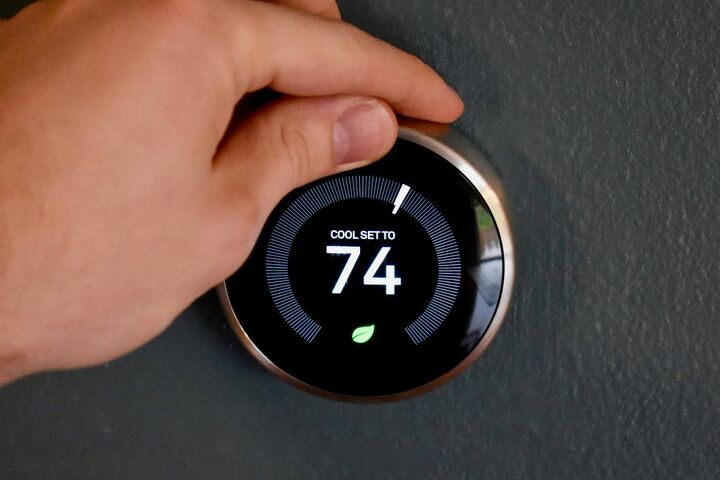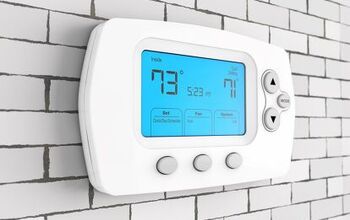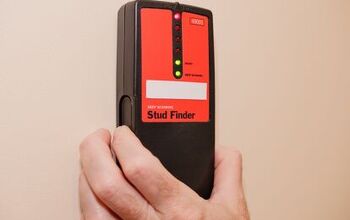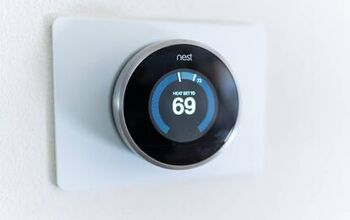Thermostat Flashing "Cool On" But Not Working? (Possible Causes & Fixes)

Troubleshooting a thermostat can be tricky between all of the messages and error codes that they display. Many homeowners have scratched their heads the words “cool on” flash on the display yet the thermostat won’t work. So, what does this message mean, and what can you do to fix it?
A thermostat can flash “cool on” without blowing air due to electrical surges and dying batteries. A “cool on” message can also appear if the thermostat logs out or times out on its own. Wait 5 minutes, restart your thermostat, and identify and replace fuse or wire damage to make it return to normal.
Thermostats can also flash a “cool on” message if it is working hard to produce cool air. This can happen even if there isn’t an event such as a power outage or electrical surge. Follow along as we explore the possible causes and solutions for a thermostat that flashes “cool on” but isn’t working.
Do You Need Your Thermostat Repaired or Reprogrammed?
Get free, zero-commitment quotes from pro contractors near you.

Possible Causes
Every thermostat is different, but you can generally count on the same primary causing for a flashing “cool on” message. With that said, it is important to understand the problem because it will help determine your solution. Let’s take a look at the three main reasons your thermostat is flashing “cool on” but isn’t working.
Dying Batteries
You can often tell that a thermostat’s batteries are dying when they start acting strangely. A flashing “cool on” message is a great example of such strange behavior, and it is often at the root of the problem. Thermostat batteries last up to 12 months, but they can die before then.
Dying batteries can cause thermostats to malfunction and display icons, error messages, and inaccurate numbers. The same can happen if you use the wrong type of battery for your thermostat. A thermostat can only work without batteries if it is wired to your home’s power, and even then they still require internal batteries.
Power Outage
Power outages are bad news for any appliance that runs on electricity, and it renders them useless. This is a big deal when it comes to HVAC systems and thermostats. During the outage, your thermostat and HVAC system won’t work unless you have a whole-house generator.
However, thermostats are known to operate poorly in the aftermath of a power outage. An outage can cause a thermostat to display incorrect messages over and over, and it can be frustrating. “Cool on” messages may flash and your AC or furnace won’t run properly in many cases.
Delay Mode
Thermostats enter a delay mode when they are underpowered or after an electrical surge. Delay modes generally last for 5 minutes, but it varies between manufacturers. It can be frustrating if you want your thermostat to work and it continually displays “cool on” messages or other notifications.
However, this process is necessary and is built into thermostats to prevent compressor damage. It can be harmful to restart your thermostat when it is in cooling mode. Compressors exert pressure, and restarting a thermostat while it’s in delay mode can cause a harmful change in pressure.
Luckily, many thermostats have built-in features that prevent users from restarting during the delay period. Whether your thermostat displays a “cool on” or “delayed” message, you should leave it alone for at least 5 minutes.
Faulty Wiring
Installation can be tricky, and it is all too easy to make a simple mistake when it comes to wiring a thermostat. Faulty wiring sometimes waits to rear its head, and it causes a thermostat to malfunction. This includes flashing messages such as “cool on” or “delay” without the thermostat working otherwise.
Licensed electricians and HVAC professionals are best suited to wire thermostats. However, if you installed your own thermostat, you may want to double-check your wiring. Even the most experienced DIYers can make a wiring mistake, and it can hinder your thermostat’s performance.
Solution
Your solution varies based on why your thermostat is flashing “cool on” without working. If your “cool on” message began flashing right after a power outage, you can narrow down your solutions. Let’s take a look at the quickest and most reliable fixes when your thermostat flashes “cool on” but just won’t work.
1. Wait
Delay mode is the most common reason for a thermostat to flash “cool on” without working. This mode indicates that something is wrong and that your thermostat is protecting the compressor. Time is the first solution in this scenario, and you need to wait it out.
The delay period allows enough time for the pressure to balance out within the compressor. Delay periods prevent expensive repairs and irreversible damage that can happen when there is too much pressure in a compressor. After 5 minutes, the pressure generally returns to normal and the thermostat will allow you to reset.
Many thermostats automatically reset, but some may make you do it manually. If the flashing doesn’t stop and it won’t you reset, it can indicate that you need to troubleshoot in other ways.
2. Inspect Fuses
Power surges and outages can blow fuses, and that can throw your HVAC system out of whack. If your thermostat started flashing “cool on” after a power surge, you need to inspect the fuses. Blown fuses are easy to identify, and you will need to replace them.
Hire a professional electrician if you are inexperienced with electrical work. It only costs $30 or less to replace fuses on your own, but it is much safer to hire an HVAC professional.
3. Replace Batteries
Dead batteries are the easiest solution besides simply waiting out the delay period. Thermostat batteries last up to one year, but they can die before then. Monitor your battery life if your thermostat displays low battery warnings.
Not all thermostats warn you when your batteries run low, and you may have to replace them when it’s too late. Thermostats typically take AA or AAA batteries, and most of them have compartments meant for two. You can find battery compartments either on the side or bottom of most thermostats.
Some thermostats require that you remove the cover to replace the batteries. Either way, it takes 1-2 minutes to replace thermostat batteries. Replace your batteries and your flashing “cool on” message will disappear in many cases.
4. Rewire Thermostat
You may need to rewire your thermostat if there is visible damage or nothing else works. It is a great idea to hire an HVAC professional or electrician to rewire your thermostat for safety purposes. However, you can rewire a thermostat safely if you pay attention to the color-coded wires.
Related Questions
Why is my Nest thermostat blinking red?
A Nest thermostat blinks red when the battery is charging. It generally takes 1 hour for a Nest thermostat to charge the battery. Nest thermostats typically automatically charge the battery when it gets low before it drains completely.
What does “error” mean on a thermostat?
“Error” appears on a thermostat followed by a code to indicate a specific problem. The code that follows the word “error” refers to specific problems such as power surges, clogged air filters, and power outages. Thermostats typically come with a manual that lists and explains what each error code means.
Are smart thermostats worth it?
Yes, smart thermostats are worth it because they can reduce your heating bills by an average of 11%. Your cooling bills can decrease by 15%, and you can program them for maximum energy savings. They can keep help regulate your temperature without using too much energy.
Can a thermostat cause short cycling?
Yes, a thermostat can cause short cycling and it can increase energy bills. Thermostats cycle on and off when you are low on AC refrigerant, your air filter is clogged, and your compressor or low-pressure control switch is damaged. Replace these parts and replenish your refrigerant so that it cycles on and off in normal intervals.
Do You Need Your Thermostat Repaired or Reprogrammed?
Get free, zero-commitment quotes from pro contractors near you.

Summing It Up
Thermostats display the message “cool on” and cease working after power surges and outages. The message generally means that the thermostat entered a 5 minute delay period to alleviate and balance the pressure in the compressor. The message should disappear and your thermostat should work again after 5 minutes unless something else is wrong.
A thermostat can flash “cool on” when the batteries are dead or dying. In this case, the thermostat will return to normal when you replace the dead batteries with fresh AAs or AAAs. Check to make sure that your fuses aren’t blown and wires aren’t damaged after a power surge.
Replace blown fuses and rewire your thermostat so that it will work properly. A thermostat that flashes “cool on” and briefly stops working generally isn’t broken, and you can quickly return it to normal.
Related Articles

Nick Durante is a professional writer with a primary focus on home improvement. When he is not writing about home improvement or taking on projects around the house, he likes to read and create art. He is always looking towards the newest trends in home improvement.
More by Nick Durante



























